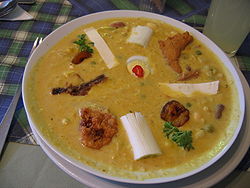This article needs additional citations for verification. (December 2016) |



| Part of a series on the |
| Culture of Ecuador |
|---|
 |
| People |
| Languages |
| Cuisine |
| Religion |
| Art |
| Literature |
| Music |
| Sport |
Ecuadorian cuisine is diverse, varying with altitude and associated agricultural conditions. Ecuadorian cuisine is an amalgamation of Spanish, Andean, and Amazonian cuisines and to a lesser degree Italian, Lebanese, African, and Chinese. Beef, chicken, and seafood are popular in the coastal regions, especially ceviche,[1] and are typically served with carbohydrate-rich foods, such as rice accompanied with lentils, pasta, or plantain. In the mountainous regions pork, chicken, beef and cuy (guinea pig) are popular and are often served with rice, maize, or potatoes. A popular street food in mountainous regions is hornado, consisting of potatoes served with roasted pig. Some examples of Ecuadorian cuisine in general include patacones (green plantain slices fried in oil, mashed up, and then refried), llapingachos (a pan-seared potato ball), and seco de chivo (a type of stew made from goat). A wide variety of fresh fruit is available, particularly at lower altitudes, including granadilla, passionfruit, naranjilla, several types of banana, uvilla, taxo, and tree tomato.
The food is somewhat different in the southern mountainous areas, featuring typical Loja food such as repe, a soup prepared with green bananas; cecina, roasted pork; and miel con quesillo, or "cuajada", as dessert. In the rainforest, a dietary staple is the yuca, elsewhere called cassava. The starchy root is peeled and boiled, fried, or used in a variety of other dishes. Across the nation it is also used as a bread, pan de yuca, which is analogous to the Brazilian pão de queijo and often consumed alongside different types of drinkable yogurt. Many fruits are available in this region, including bananas, tree-grapes, and peach-palms.
- ^ Duarte-Casar, Rodrigo; Robalino-Vallejo, Jessica; Buzetta-Ricaurte, María Fernanda; Rojas-Le-Fort, Marlene (2022-05-12). "Toward a characterization of Ecuadorian ceviche: much more than shrimp". Journal of Ethnic Foods. 9 (1): 16. doi:10.1186/s42779-022-00131-w. ISSN 2352-6181.